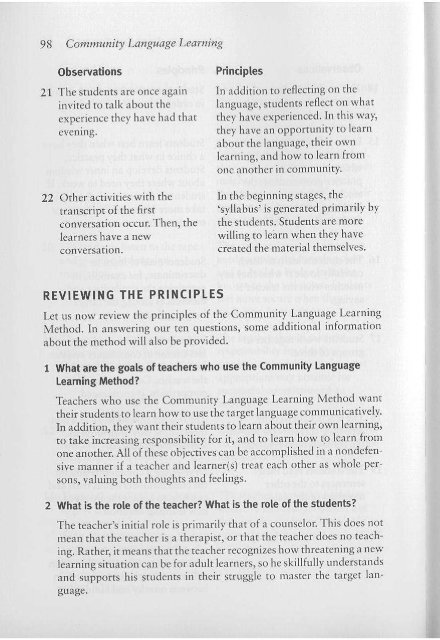Diane Larsen-Freeman
larsen-freeman-techniques-and-principles-in-language-teaching
larsen-freeman-techniques-and-principles-in-language-teaching
- No tags were found...
You also want an ePaper? Increase the reach of your titles
YUMPU automatically turns print PDFs into web optimized ePapers that Google loves.
9g Community Language Learning Community Language Learning 99<br />
Observations<br />
2 1 The students arc once again<br />
invited to talk about the<br />
experience they have had that<br />
cvenmg.<br />
22 Other activities with the<br />
tran script of the first<br />
conversation occur. Then, the<br />
learners have a new<br />
conversation.<br />
REVIEWING THE PRINCIPLES<br />
Principles<br />
In addition to reflecting on the<br />
language, students reflect on what<br />
they have experienced. In this way,<br />
they have an opportunity to learn<br />
about the language, their own<br />
learn ing, and how to learn from<br />
one another in community.<br />
In the beginning stages, the<br />
'syllabus' is generate d primarily by<br />
the students . Students are more<br />
willing to learn when they have<br />
created the material themselves.<br />
Let us now review the principles of the Community Language Learning<br />
Method. In answering our ten questions, some additional informat ion<br />
about the method will also he provided.<br />
1 What are the goals of teachers who use the Community Language<br />
learning Method?<br />
Teachers who use the Community Language Learning Method want<br />
their students to learn how to usethe target language com municatively.<br />
In addition, theywant their students to learn about their own learning,<br />
to take increasing responsibility for it, and to learn how to learn from<br />
one another. All of these objectives can be accompl ished in a nondcfcnsivc<br />
manner if a teacher and learner(s) treat each other ,1S whole persons,<br />
valuing both thou ghts and feelings.<br />
2 What is the role of the teacher? What is the role of the students?<br />
The teacher's initial role is primarily that of a cou nselor. This docs not<br />
mean that rhe reacher is a therapist, or that the teacher docs no teaching.<br />
Rather, ir means rhar the teacher recognizes how threatening a new<br />
learning situation can be for adu lt learners, so he skillfully undersrauds<br />
and supports his students in their struggle to master the target language.<br />
Initially t he learners are very dependent upon the teacher. It is recognized,<br />
however, that as the learn ers cont inue to study, they become<br />
increasingly independent. Community Language Learning methodologists<br />
have identified fi ve stages in this movement from dependency to<br />
mutual interdependency with the reacher. In Stages I, II, and III, the<br />
teacher focuses not only on the language but also on being supportive<br />
of learners in their learning process. In Stage IV, because of the students'<br />
greater security in the language and readiness to benefit from cot rcctions,<br />
the teacher can focus more on accuracy. It shou ld be noted that<br />
accuracy is always a focus even in the first three stages; however, it is<br />
subordinated to fluency. The reverse is t rue in Stages IV and V.<br />
3 What are some characteristics of the teaching/learning process?<br />
In a beginning class, which is what we observed, students typically<br />
have a conversation using their native language. The teacher helps<br />
them express what they want to say by giving them the target language<br />
translation in chunks. These chunks arc recorded, and when<br />
they are replayed, it sounds like a fairly fluid conver satio n. Later, a<br />
transcript is made of the conversation, and native language equ ivalents<br />
arc written beneath the target language word s. The transcription<br />
of the conversation becomes a 'text' with which students work.<br />
Various activities arc conducted (for exampl e, examinati on of a<br />
grammar point, working on pronunciation of a particular phrase, or<br />
creating new sentences with wor ds from the tra nscript) rhat allow<br />
students to furt her explore the language they have generated. During<br />
the course of the lesson, students are invited to say how they feel, an d<br />
in rerum the teacher understan ds them .<br />
Accord ing to Curran, there are six elements necessary for nondcfensive<br />
learning. The first of these is security. Next is aggression, by<br />
which Curran means that students shoul d be given an opportun ity to<br />
assert themselves, be actively involved, and invest themselves in the<br />
learning experience. One way of allowing for this in the lesson we<br />
observed was for students to conduct their own conversation. The<br />
third element is attention. One of the skills necessary in learnin g a second<br />
or foreign language is to be able to attend to many factors simultaneously.<br />
To make this skill easier to learn , especially at the<br />
beginning of the learnin g process, the teacher helps to narrow the<br />
scope of attention. Recall that the reacher in our lesson asks the students<br />
not to copy the transcript while he was writ ing it on the blackboard<br />
. lnstead, he wanted them to atten d to what he was writing and


